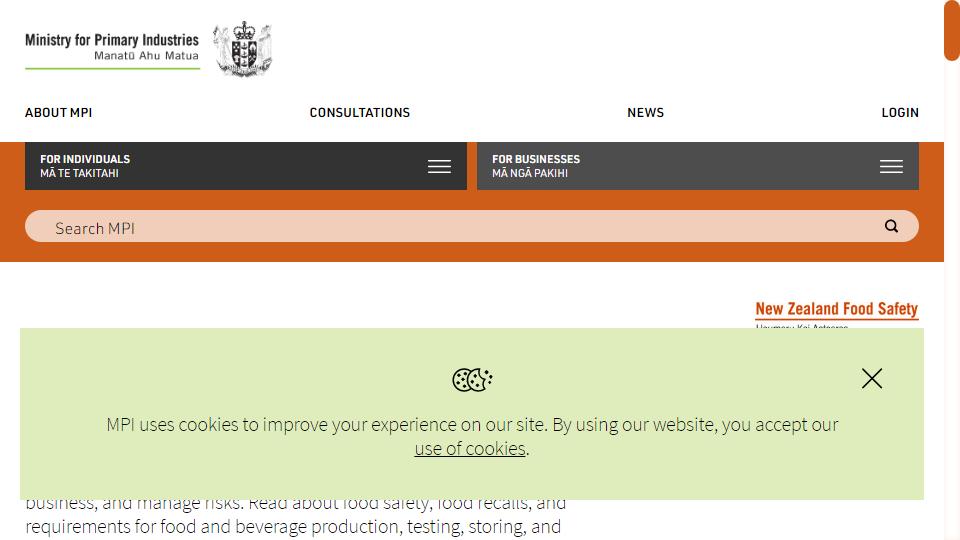

FoodSafety:New Zealand The Food Safety Authority is a New Zealand government agency responsible for the quarantine and certification of all agricultural, aquatic and food products, including dairy products, that are exported to New Zealand. It can also be considered as the equivalent of the General Administration of Import and Export Inspection and Quarantine in China.
New Zealand Food Quality and Safety Authority, the full name of the New Zealand Food Safety Authority, abbreviated as NZFSA; dairy exports are one of the pillars of New Zealand's economy, so the NZFSA's biggest and strongest focus is on the production, management, sale and export of dairy products.
To ensure that New Zealand's national revenue is stable, the New Zealand Food Safety Authority makes every batch of dairy products that goes into the country and overseas a strict test target. New Zealand's dairy risk management regulations, there are strict raw material inspection procedures, all dairy farms, collection equipment, collection process used in the safety procedures must be strictly certified and approved by the New Zealand Food Quality and Safety Authority.
The production and processing of New Zealand dairy products, from farm to processing plant, must comply with the New Zealand Food Safety requirements of the New Zealand Food Code. This includes restrictions on relevant microbiological and chemical indicators. For example, each batch of infant formula exported to China must undergo rigorous and comprehensive testing to ensure that it is not infected with various unhealthy bacteria, such as E. sakazakii, and that all indicators meet international standards before it can obtain a health certificate and a marketing authorization certificate from the NZFSA for each batch of product. NZFSA will not issue a marketing authorization for products that fail the test.
New Zealand's good food hygiene is based on a number of regulations. Since 1974, New Zealand began to implement the "Food Hygiene Ordinance", and in April 1994, the "Food Safety Act" was further passed, which is quite concise: firstly, it stipulates that food must be safe and meet quality requirements; secondly, the Act stipulates that food Once the safety and quality problems occur, consumers have the right to request the seller or manufacturer to assume responsibility; again, the "Food Safety Law" provides that if the two sides disagree, can be submitted to the arbitration court to resolve.
The above regulations are translated into a hierarchical assessment system in the specific implementation. In Auckland, New Zealand's largest city, the food safety monitoring department has divided hotels and restaurants into four levels of hygiene: A, B, D and E. Level A is in line with high standards, B is in line with standards, D is only in line with standards, and E is not in line with standards. These standards are publicized on the website, according to which customers can choose restaurants. Generally speaking, restaurants rated as E are not doing much business and will soon be forced to close. Under this grading system, almost every restaurant takes food safety and hygiene very seriously, as a top priority.
For the safety and quality of various food products, the management department has established industry regulations based on the Food Sanitation Ordinance and the Food Safety Law. For example, the "Milk Industry Act 1952" and the "Milk Industry Act 1990" were enacted to improve the accuracy of control and ensure the safety and quality of milk products during manufacture, transportation and storage, and the latter was amended in 2003. The latter was amended in 2003.
It is observed that New Zealand's food safety regulations are generally very concise and clear. The most crucial thing is that the enforcement process is very strict and transparent, and there are very few instances of lax enforcement and bending the law.
The New Zealand Food Safety Authority is the highest government authority for food hygiene and quality and was restructured and established in July 2002 to ensure effective enforcement of food safety laws in New Zealand. Previously, there was an overlap of regulatory functions and inconsistent enforcement of regulatory standards in New Zealand, resulting in disputes and conflicts between regulatory authorities, producers and sellers, and consumers. The establishment of the Food Safety Authority has effectively solved this problem, thus ensuring that there is a law to follow and that enforcement is strict and effective.
Recently, the Food Safety Authority launched a nationwide consultation campaign to revise the Food Safety Regulations. The Food Safety Bureau Secretary Andrew McKenzie said that the "Food Safety Ordinance" has been implemented for more than 30 years without major amendments, and over the past years, the structure of people's food, food production methods and health and safety standards, have changed greatly, the national food supply and consumption market has changed a lot, in order to further unify In order to further unify the national food hygiene and safety standards and coordinate the enforcement mechanism, it is necessary to amend the regulations. For this nationwide consultation, on the one hand, is the requirements of the New Zealand law-making process, on the other hand, the government hopes to mobilize enterprises, authorities and the public to pay attention to food hygiene and safety, common concern about this issue of life and health.
It is understood that in the past 30 years in New Zealand, there has not been a group of serious food health and safety incidents, the reason for this, in addition to the effective and scientific laws and regulations, law enforcement agencies do not play favorites, not to bend the law, a very important point is the instinctive care for life of the whole community.

Links : poudr.xyz
This site is free of charge to add web sites. If you are interested, you are welcome to contribute! Contact Email:[email protected] ‖ Contact
Copyright © 2018-2025 en.sitegaga.com All Rights Reserved.